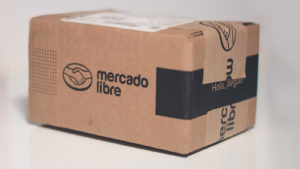
Investors looking to capture the continued growth in e-commerce would do well to invest in the three stocks outlined below. Traditional brick and mortar retail continues to struggle.
Even with the lifting of pandemic restrictions, there isn’t much hope for a continued rebound. Technology has greatly increased the convenience of the retail experience. Internet connectivity is ubiquitous and smartphones are a vital part of our daily lives. Those factors have conspired to create a boon for the e-commerce industry.
E-commerce revenues are expected to grow at 9.5% annually over each of the next four years. It all suggests that investing in e-commerce stocks is a wise choice. The e-commerce landscape is diverse but there are a few dominant players at the same time. It continues to make sense to invest in those firms. At the same time, there are other important global players that investors should also consider. Let’s take a look at them.
Amazon (AMZN)

Amazon (NASDAQ:AMZN) is far and away the biggest e-commerce firm globally. Any list of e-commerce stocks would be incomplete without the inclusion of Amazon. Just how big is it?
Total sales reached $574.8 billion in 2023. That was an increase of 12% over the previous year. However, that also includes substantial contributions outside of e-commerce from sources including Amazon’s AWS Cloud among others. Amazon reported $412.1 billion in online sales in 2023.
That still doesn’t tell us just how big Amazon is. Consider this: Prime membership subscriptions accounted for more than $40 billion in revenues in 2023. Those revenues alone would make it the third-largest retailer if the company were isolated along those lines.
Such a large size naturally raises questions about growth potential. Amazon’s ecommerce business nearly doubled between 2019 and 2023. In my mind that provides a strong counterpoint to such concerns. Amazon remains the first and best choice among e-commerce stocks.
MercadoLibre (MELI)

MercadoLibre (NASDAQ:MELI) is another prominent name in the world of e-commerce and a company that is often compared to Amazon. The company serves the Latin American market from Mexico to Argentina. It has carved out a dominant position in Latin American e-commerce which has sent its stock much much higher.
The company is part e-commerce champion and part fintech superstar. Overall revenues grew by 42% in the most recent quarter. Mercado Libre is the rare company that dominates its region while simultaneously experiencing hyper growth. On the fintech side, MercadoLibre saw payments volume increase by more than 57% in the 4th quarter. The company’s Mercado Pago offering has served to bring customers to its platform and is very clearly growing at a rapid pace.
The company served nearly 85 million unique buyers in 2023 overall. Some investors May worry that MercadoLibre’s growth is limited due to demographic trends. Latin America, like many parts of the world, is undergoing demographic stagnation. However, the company clearly can continue to penetrate the markets it already dominates and reach substantial untapped customers.
Walmart (WMT)

Walmart (NYSE:WMT) is much better known for traditional brick-and-mortar retail than e-commerce. The company continually battles against Amazon for overall retail dominance. That means Walmart continues to challenge Amazon concerning e-commerce.
Walmart is doing very well in that regard. E-commerce sales eclipsed the $100 million mark for the first time in 2023. During the 4th quarter online sales grew by 17% in the U.S. at Walmart. Online sales grew 23% globally during the same period.
The number of Walmart marketplace sellers increased by 20% during the same time. That’s a strong sign in relation to its competitiveness with Amazon where marketplace sellers had long flocked.
Walmart continues to establish itself as a more e-commerce oriented firm of late. Meanwhile, it continues to dominate brick-and-mortar retail and remains the largest grocery store in the United States. It’s a great stock overall and one for e-commerce investors to consider as well.
On the date of publication, Alex Sirois did not have (either directly or indirectly) any positions in the securities mentioned in this article. The opinions expressed in this article are those of the writer, subject to the InvestorPlace.com Publishing Guidelines.







